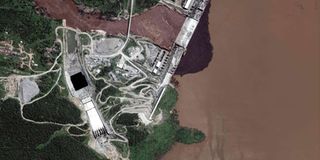Ethiopia to start generating power from dam in months

A satellite image shows a view of northwestern Ethiopia that focuses on the status of the Grand Ethiopian Renaissance Dam (GERD) and the Blue Nile River on July 11, 2020. PHOTO | MAXAR TECHNOLOGIES | AFP
What you need to know:
- Egypt and Sudan had warned Ethiopia against filling the dam until talks are completed.
- Water and Irrigation Minister Seleshe Bekele said the dam has a reserve of 4.9 billion cubic metres which will enable Ethiopia to start generating electricity in a few months.
Ethiopia’s office of the Prime Minster announced yesterday that the first round of filling the Grand Ethiopian Renaissance Dam (GERD) is completed, with the government hinting that it will start generating electricity in a few months.
The announcement comes after Ethiopia, Sudan and Egypt agreed to resume dam talks after previous negotiations stalled.
PM Abiy Ahmed appeared on State TV and gave a congratulations message to Ethiopians.
"It has become evident over the past two weeks in the rainy season that the GERD first year filling is achieved and the dam under construction is already overtopping," he said in a statement.
The news of filling came as a surprise to Ethiopians as they didn’t expect that the dam would be filled in such a short time.
Water and Irrigation Minister Seleshe Bekele said the dam has a reserve of 4.9 billion cubic metres which will enable Ethiopia to start generating power in a few months.
The country plans to fill the dam to a capacity of 13.5bn cubic metres during next year’s rainy seasons.
The Ethiopian Electric Power Corporation said that after the dam was filled there have been no complaints from Egypt and Sudan.
However, last week, Sudan had raised alarm over a sudden drop in Nile water levels. At the time, Ethiopia had denied filling of the dam’s reservoir, with Mr Bekele insisting that any changes in water levels as seen in satellite images shared by Reuters were due to heavy rains.
Egypt and Sudan had warned Ethiopia against filling the dam until talks are completed.
Ethiopia is currently exporting hydroelectricity to Djibouti and Sudan.
Kenya also has an agreement with Ethiopia over importation of electricity.





